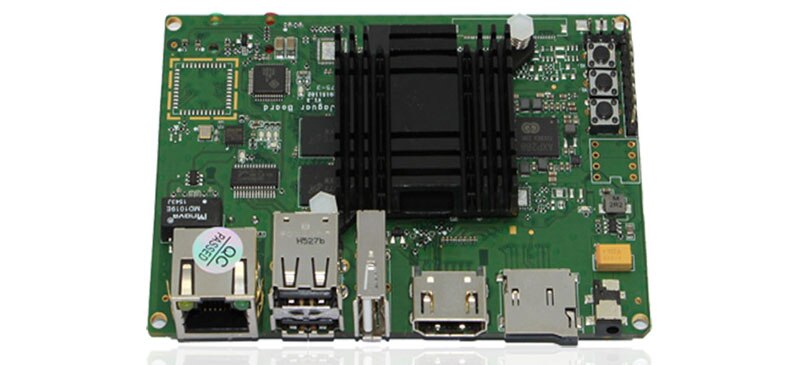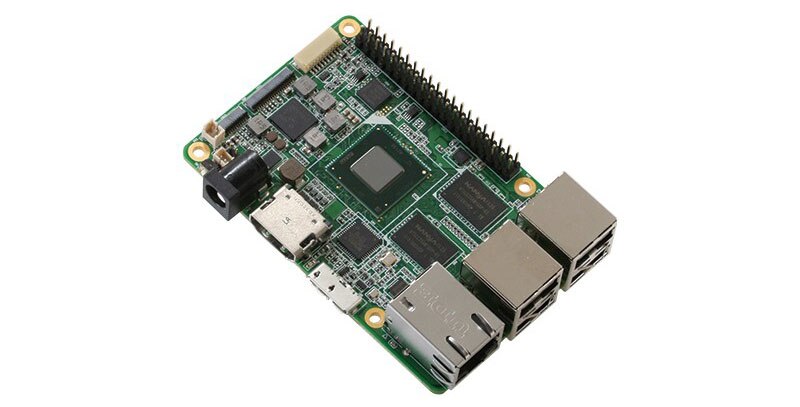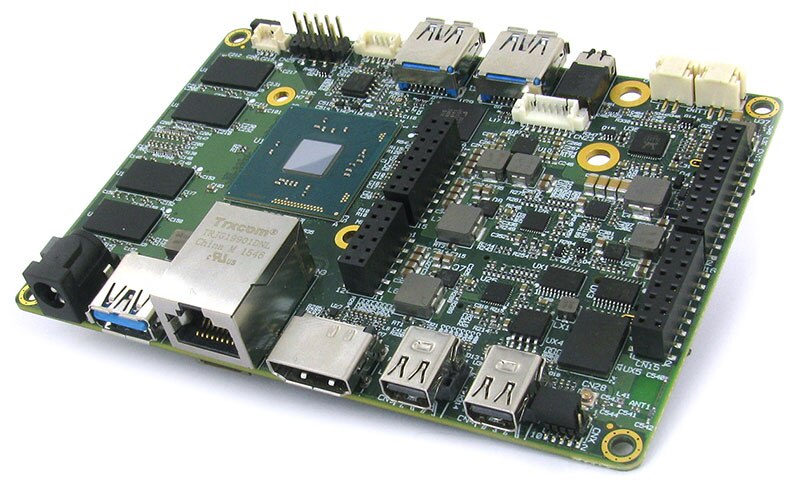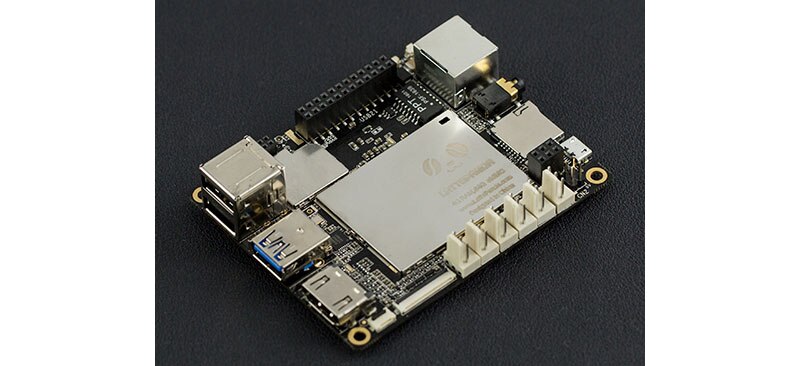Intel Inadvertently Challenges ARM in the Single Board Computing Market with its x86 SoC
2016-11-15 | By Maker.io Staff
This year in 2016 we have seen an influx in x86 based single board computers (SBCs) in the maker market with the UDOO x86, JaguarBoard, LattePanda and now UP Squared. All of which feature an Intel based SoC with faster processing and reduced power consumption, putting them in contention with conventional ARM SBC’s. Although the cost is much higher in the new x86 based boards the benefits of the powerful SoC far out weight the cost increase. All new SBCs offer a basic version of their boards for around the $89 mark, which seem to be the standard in pricing tiers.
All of the featured boards have collectively raised $1.5 million with almost 10,000 backers and all feature an Intel SoC. This sudden change in the maker market is due to the advancement in Intel’s SoC technology as well as a price decrease making it more affordable for manufacturers and makers alike. Intel’s x86 processors also allow manufacturers to use full x86 operating systems such as Windows 10, Linux Ubuntu and Android. Although chips alike have been precisely available the slow uptake has been due to the high power consumption in contrast to the ARM based chips.
Start Ups
It’s important to know that these new x86 single board computers are not backed by Intel or AMD, they are indeed start-up companies bridging the gap between microcontrollers and single board computers for the makers. Intel already has the Atom-based MinnowBoard Max, Intel Edison and Quark-based Galileo, AMD has the Gizmo 2 board. However, none of those boards are configured with chips as powerful as those driving the new boards, especially the 14nm Atom driven boards with advanced power saving technology.
At the start of this year 2016, Intel created a lower-cost Apollo Lake Atom SoC for mobile devices such as tablets and mini-PCs. The Apollo Lake features a 14nm SoC package with ‘Goldmont’ cores as well as the next generation of graphics.
Even though chips like these are not focused on the embedded market, the low price and reduced power consumption along with embedded like features such as GPIO, PWM, I2C and SPI make them an ideal single chip solution.
Pricing is still a fairly grey area in the single board computing market, these new x86 boards range between $80 to $240 depending on spec whilst the best ARM single board computers retail around the $35 in-line with the Raspberry Pi 3.
JaguarBoard – Jaguar Electronics HK

JaguarBoard
One of the first boards we came across this year was the JaguarBoard, which launched on Kickstarter in January 2016 and has already been shipped out to 600 backers. This particular board is the most affordable board coming in at $79 for the basic model, it was offered to KickStarter backers at $65 initially.
The lower price of the JaguarBoard is due to the fact that it runs on an older 22nm Intel “Bay Trail” Atom Z3735G and only offers 1GB of RAM and 16GB of flash memory. Although this board could run Windows 10, I would say it was primarily aimed at other Linux distributions. The board features and SD slot of expansion, HDMI video output, 10/100 Ethernet for network connectivity, 3x USB 2.0 ports for peripherals and a number of other input/outputs. The total power consumption form the JaguarBoard is 7.5W.
UP Board

UP Board
The UP Board came shortly after the JaguarBoard at the start of 2016 backed by Asus Aaeon Europe. Also funded through KickStarter the UP board was shipped to backers in May. The UP Board features the Intel “Cherry Trail” 14nm Atom X5-Z8300 and also uses the same form factor as the Raspberry Pi computer including a 40-pin GPIO connector.
The quad-core “Cherry Trail” Atom x5 processor is clocked at 1.44GHz and can provide up to 4k HDMI output resolution using Intel HD 400 Graphics. There are a number of various options available in terms of specification, 1GB ($89) or 2GB ($99) DDR3L-1600 RAM, each comes with 16GB flash with option for expansion to 32GB. There is currently a newer version at 4GB with 32GB of flash memory that goes on sale at $149.
Intel have taken up this board in conjunction with their RealSense depth-sensing Camera Kit for robotics. The UP board also ships with a DSi and eDP display interfaces whilst also offering CSi and I2s audio ports. Other features of the board are in parallel with other similar boards such as Gigabit Ethernet, 3x USB 3.0 ports and a massive 6x USB 2.0 for peripheral interfaces.
UDOO x86

UDOO x86 Board
The UDOO x86 has by far been the most exciting board I have seen this year, and I’m one of the proud backers in their KickStarter campaign. The UDOO x86 project is known for its open-spec, raising $800,000 on KickStarter with the basic version coming in at $89. The UDOO x86 uses Intel’s quad-core 14nm “Braswell” Atom and Celeron processors. It is claimed that this board is “the most powerful maker board ever” shipping in November 2016.
The UDOO x86 came in a number of flavours with the UDOO x86 basic clocked at 1.04GHz for $89 including 2GB of RAM and an Atom x5-E8000 SoC. There is also a $129 UDOO x86 Advanced with 4GB and a much faster Celeron N3160 clocked at 1.6GHz and what’s more impressive is these boards both can run three simultaneous displays at 4k resolution.
Later in the campaign, UDOO gave backers the option to upgrade the eMMC flash memory from the standard 8GB to 32GB for only an extra $12. The board features a microSD and SATA connector for additional storage expansion. It also features a HDMI and dual Displayport++ ports, S/PDIF and analog audio outputs. Other standard features are Gigabit Ethernet, 3x USB 3.0 ports, IR interface and 20x GPIO pins. There is also a M.2 slot for supporting additional wireless modules, however other boards come with built-in wireless modules as standard.
The UDOO x86 is also one of the first boards to use the Intel Curie module, which can be found on the latest Arduino 101 development board and featured in the hit TV show “World’s Greatest Makers”. The Curie module features Bluetooth Low Energy and a Quark SE microcontroller. UDOO’s take on the Curies module allows users to enable Arduino programming with the Arduino IDE as well as support for shields and access to the large Arduino community.
LattePanda

LattePanda Board
The LattePanda board actually came to use in 2015 through their KickStarter campaign but only recently started to gain some traction in the maker market. The board raised over $400,000 and was shipped to backers in April 2016. This board came out of the far east market from Shanghai, with the basic version at only $79 with built-in WiFi. The LattePanda is marketed as the Windows 10 single board computer, whilst other boards are using Linux. The board uses the Intel “Cherry Trail” quad-core SoC clocked at 1.8GHz with 2GB of DDR3L RAM and 32GB of eMMC flash memory. What’s more impressive is that Windows 10 already comes pre-installed as standard and there is the option to purchase the board with a Windows 10 license.
The LattePanda also comes with a ATmega32u4 microcontroller, the same as featured on the Arduino Leonardo. You can program the Arduino side of things using the Arduino IDE pre-installed as well as in VisualStudio.
Other features include 1080p HDMI output, display connectors for IPS display and touchscreen overlay, 1x USB 3.0 and 2x USB 2.0 ports, 3.5mm audio jack, Ethernet and built-in WiFi with external antenna connector. I have personally been playing with the LattePanda board and you can see my write up on Maker.io website.
X86 Board Comparison
Below is a specification comparison, if you are interesting to acquiring a high spec maker board then the below table will help you decide which board to purchase for your maker needs. The specifications below are based on the highest spec boards that are available in that range, you can follow the links in the title for further information.
| JaguarBoard | UP Board | UDOO x86 Ultra | LattePanda | |
| System-on-chip | Intel Cherry Trail | Intel Pentium | Intel Cherry Trail | |
| Processor | Z3735G 1.83GHz | x5-Z8350 1.92GHz | N3710 | X5-Z8300 1.8GHz |
| Microcontroller | N/A | Intel Curie | ATmega32u4 | |
| GPIO | 4 | 40 | 20 | 20 |
| RAM | 1GB DDR3L | 4GB DDR3L | 8GB DDR3L | 4GB DDR3L |
| Graphics | Unknown | Intel HD 400 500MHz | Intel HD 405 700MHz | Intel HD 400 500MHz |
| Display | 1x HDMI | 1x HDMI, DSi/eDP | 1x HDMI, 2x mini DP++ | 1x HDMI, MIPI-DSi |
| Storage | 16GB eMMC | 64GB eMMC | 8GB eMMC | 64GB eMMC |
| Ethernet | 10/100 | 10/100 | 10/100 | 10/100 |
| Wireless | N/A | N/A | Optional M.2 Modules | 802.11AC WiFi Bluetooth 4.0 |
| Audio | 3.5mm Jack | HDMI | S/PDIF, 3.5mm Jack | 3.5mm Jack |
| Power | 5V DC Jack | 5V DC Jack | 12V DC Jack | 5V microUSB |
| Open Source | No | No | Yes | NO |
| OS Supported | Fedora, Ubuntu, Debian, CentOS, Windows 10, Android | Ubuntu, Yocto, Windows 10, Android Lilipop, Brillo | Linux, Android, Windows | Windows 10, Ubuntu, Android |
| Price | $79 | $149 | $259 | $139 |
Summary
There is no doubt that these board are going to be, if not already, very popular amongst makers and hobbyists alike. Ultimately the market for x86 boards will get bigger as the chips get cheaper and more sophisticated with enhanced power management and embedded like features. Intel has certainly grasped the maker market inadvertently and has soon become very competitive to ARM dev boards. This is becoming an Intel Vs ARM saga one which only the makers will benefit. For me personally, there is only one of the boards above which I would consider to be supreme in terms of features and price, however I will leave it up to you to decide your favourite x86 board.

Have questions or comments? Continue the conversation on TechForum, DigiKey's online community and technical resource.
Visit TechForum






 中国
中国